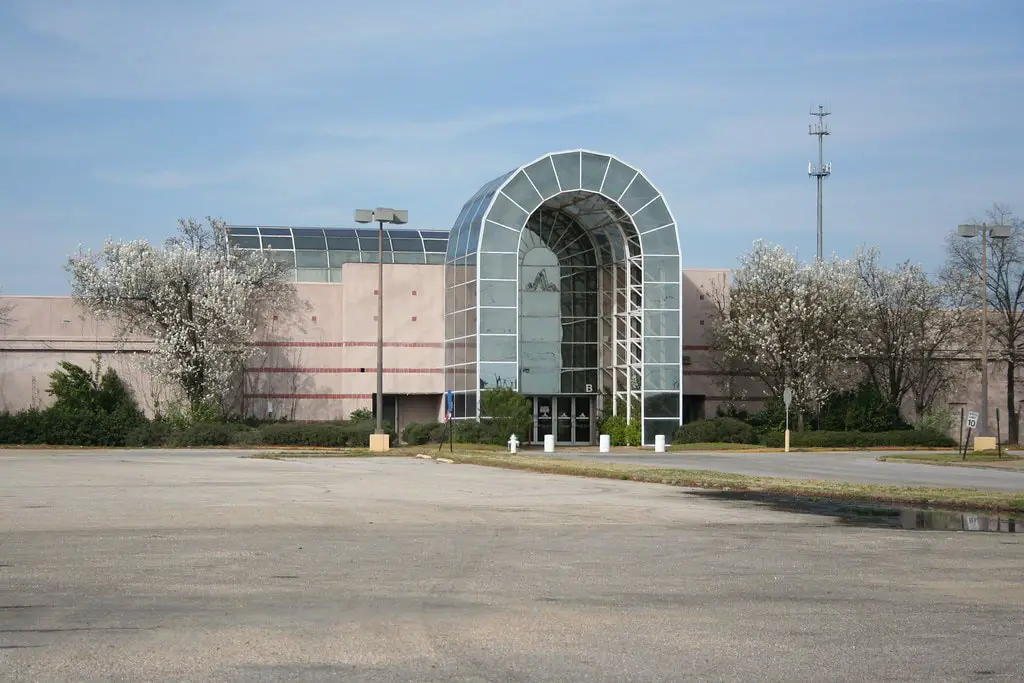Opening and Early Years
Montgomery Mall opened in 1970 in Montgomery, Alabama. The developers, Jim Wilson & Associates, aimed to create a premier shopping destination.
Montgomery Fair and JCPenney were the initial anchor stores, drawing significant customer traffic.
In addition to these anchors, the mall housed various stores such as Lerner New York, Singer Sewing Center, Morrison’s Cafeteria, and Elmore Variety Store.
These stores catered to different shopping needs, from fashion to dining to home essentials.
Montgomery Mall quickly became a central part of the community by offering diverse retail options.
The presence of well-known chains attracted shoppers from across the region, making it a popular spot for things to do in Montgomery, Alabama.
Over the years, the mall has become a key player in the local retail market.
Expansion in the Late 1980s
In 1987, Montgomery Mall began an expansion project to attract more shoppers.
They added a new wing, which was completed in 1988. This expansion made Parisian a new anchor store, enhancing the mall’s appeal.
The expansion introduced new retail spaces and stores like The Limited, Foot Locker, and B. Dalton Bookseller.
These stores offered more variety, making the mall a more attractive shopping destination.
The food court also saw new additions, including Chick-fil-A and Sbarro. These options provided shoppers with convenient dining choices, encouraging them to spend more time at the mall.
The late 1980s expansion marked a period of growth for Montgomery Mall, boosting its popularity and solidifying its place in the local retail scene.
Changes in Ownership and Initial Decline
In 1998, Glimcher Realty Trust bought Montgomery Mall for $70 million. This purchase aimed to revitalize the mall, but the early 2000s brought challenges.
Many stores began closing, such as Piccadilly Cafeteria in 2004 and Gap and Eddie Bauer soon after.
By 2005, JCPenney and Dillard’s, which had acquired the Gayfers chain, shut their doors at Montgomery Mall.
JCPenney moved to Eastdale Mall, and Dillard’s relocated to The Shoppes at Eastchase.
These closures marked the beginning of the mall’s decline.
Despite these setbacks, Steve & Barry’s opened in the former Dillard’s space in early 2005.
However, the mall lost other tenants, such as Ruby Tuesday and American Eagle Outfitters.
This period saw the mall struggling to maintain its relevance and appeal.

Continued Decline and Anchor Store Departures
By the mid-2000s, Montgomery Mall faced more closures. Parisian shut its doors in 2006, leaving another large space vacant. This added to the challenges the mall already faced.
In 2007, the mall’s owner, Glimcher Realty Trust, faced criticism from Montgomery’s mayor.
The mayor accused Glimcher of using the mall for tax benefits without making improvements.
This criticism highlighted the lack of investment in the mall’s future.
The mall closed in 2008, with Steve & Barry’s being the last major tenant to leave.
They stayed until September 2008, but their departure marked the end of Montgomery Mall as a retail destination.
The once-bustling mall now stood empty, awaiting a new purpose.
Redevelopment Progress
In May 2011, Keith Corporation announced plans to purchase 440,000 square feet of Montgomery Mall and convert it into health offices, giving the mall a new lease on life.
By 2013, the redevelopment of Montgomery Mall started to take shape. The former JCPenney store became a public library, providing a valuable resource for the community.
This new library opened in early 2014, offering educational and recreational materials for residents.
The old Steve & Barry’s space transformed into a fire station. This change improved local emergency services and added a practical function to the once-vacant building.
The fire station began operations in mid-2014, enhancing the safety and security of the area.
The Parisian building found a new role as part of the Montgomery Technical Education Center.
This facility started offering technical and vocational training in late 2014.
These changes repurposed the mall’s space, making it a community service and education hub.

Montgomery Regional Workforce Training Center
The Montgomery Regional Workforce Training Center (MRWTC) is part of the former Montgomery Mall.
Operated by AIDT, it partners with Montgomery Public Schools, Alabama Community College System, ATN, AUM, the Department of Education, and the Montgomery Area Chamber of Commerce.
The center’s mission is to provide training that meets the needs of the region’s businesses.
The MRWTC offers various free training programs to the general public and companies.
These programs lead to certifications that help place students into jobs with local businesses.
Training covers entry-level skills, existing employee upgrades, two-year technical college-level courses, and K-12 career training.
This comprehensive approach ensures that companies in Montgomery have a well-trained workforce.
The MRWTC provides a wide range of training opportunities.
By equipping individuals with the skills needed for in-demand industries, the MRWTC plays a crucial role in the economic development of the Montgomery region.
LAMP High School’s Move to Montgomery Mall
In 2017, LAMP High School moved to the old Montgomery Mall. Due to structural issues at its previous building, the school had been searching for a suitable site.
The former Parisian department store in the mall became LAMP’s new home.
The move to Montgomery Mall was part of a broader effort to repurpose the mall space for educational purposes.

The school district renovated the area to fit the needs of a modern high school.
This new site offered updated facilities, better resources, and a fresh start for the students and staff.
LAMP High School, known for its rigorous academic programs, thrived in its new location.
The school’s relocation helped bring new life into the former retail space, becoming a hub for education and community activities.
This change marked a new chapter for the mall and the school, illustrating how former commercial spaces can be effectively repurposed.
